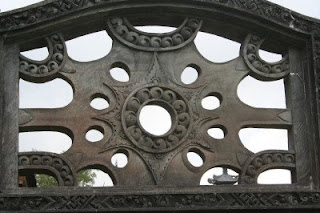I ran a workshop at the gallery on Tuesday and collected some stories about breeze blocks.
'Bricklayers didn't like using them as they need to be lifted with 2 hands therefore slow to lay and difficult to get up a rhythm.'
'The blocks that were used in the 1940 were heavy. The ones in the 60's were much lighter'
'The bocks were very cheap, could have been about 20c each.'
"We called them bessar, (besser) blocks.'
'We had a mould and would go in to the back yard and help dad make blocks. A family day.'
'My dad made cement flower pots. He got a mould and packed a dry mix of cement into the mould and press it down.'
Wednesday 25 February 2009
Tuesday 10 February 2009
How are they are put together
How are the patterns repeated? Symmetrical or Assymetrical. Do you reflect an assymetrical pattern to make it symmetrical? Do you combine two symmetrical patterns to create an assymmetrical one? Did you have enough of the one pattern to finish the job? Do they put in one that didn't match? Did you put in one that didn't match?

Bali
In Canberra
Breeze blocks




These walls have been in my life for over 20 years, a view from the kitchen window. The concrete is rotting and the masonry is breaking down. Stan who built these walls has past away. He at the age of 75 used to ride a dragster bike with a small cart attached and ride along the road to collect blue metal from the edges for this concrete mixing.
Subscribe to:
Posts (Atom)
















